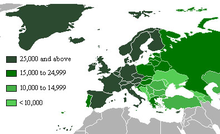Portal:Business/Selected economy/August 2011

The economy of Europe comprises more than 731 million people in 48 different states.[1] Like other continents, the wealth of Europe's states varies, although the poorest are well above the poorest states of other continents in terms of GDP and living standards. The difference in wealth across Europe can be seen in a rough East-West divide. Whilst Western European states all have high GDPs and living standards, many of Eastern Europe's economies are still rising from the collapse of the communist Soviet Union and former Yugoslavia. Throughout this article "Europe" and derivatives of the word are taken to include selected states whose territory is only partly in Europe – such as Turkey, Azerbaijan, and the Russian Federation – and states that are geographically in Asia, bordering Europe – such as Armenia and Cyprus.
Europe was the first continent to industrialize – led by the United Kingdom in the 18th century – and as a result, it has become the richest continent in the world today and the nominal GDP in 2010 is $19.920 trillion[2] (32.4% of the World).
- ^ "Europe Economy". University-world.com. Retrieved 26 April 2011.
- ^ [1]. Last accessed 3 December 2010.
